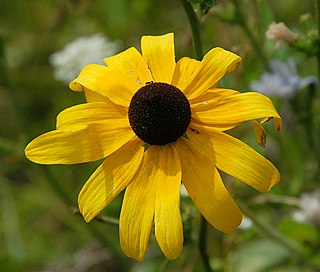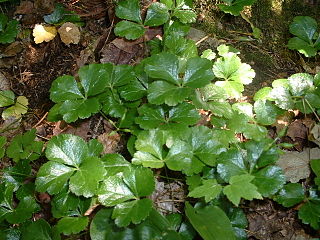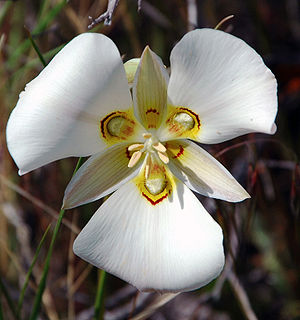
Lantana is a genus of about 150 species of perennial flowering plants in the verbena family, Verbenaceae. They are native to tropical regions of the Americas and Africa but exist as an introduced species in numerous areas, especially in the Australian-Pacific region, South and Northeastern part of India. The genus includes both herbaceous plants and shrubs growing to 0.5–2 m (1.6–6.6 ft) tall. Their common names are shrub verbenas or lantanas. The generic name originated in Late Latin, where it refers to the unrelated Viburnum lantana.

A wildflower is a flower that grows in the wild, meaning it was not intentionally seeded or planted. The term implies that the plant probably is neither a hybrid nor a selected cultivar that is in any way different from the way it appears in the wild as a native plant, even if it is growing where it would not naturally. The term can refer to the flowering plant as a whole, even when not in bloom, and not just the flower.

Rudbeckia hirta, commonly called black-eyed Susan, is a North American flowering plant in the family Asteraceae, native to Eastern and Central North America and naturalized in the Western part of the continent as well as in China. It has now been found in all 10 Canadian Provinces and all 48 of the states in the contiguous United States.

Xerophyllum tenax is a North American species of plants in the corn lily family. It is known by several common names, including bear grass, soap grass, quip-quip, and Indian basket grass.

Vitis cinerea, the graybark grape, is a variety of grape. It has small black berries that are mildly unpleasant to eat. Plentiful in Missouri and Louisiana, it is also found throughout the eastern half of the US as far west as Texas, north to Illinois, and south to Florida. It is also known by the name winter grape or possum grape.

Monarda citriodora is a species of flowering plant in the mint family, Lamiaceae, that is native to the southern United States and northern Mexico. Common names include lemon beebalm, lemon mint and purple horsemint. When crushed, the leaves emit an odor reminiscent of lemons. This odor is sometimes described as more resembling oregano, especially late in the season. Its purple flowers are highly attractive to butterflies, bees and hummingbirds.

Mentha arvensis, the corn mint, field mint, or wild mint, is a species of flowering plant in the mint family Lamiaceae. It has a circumboreal distribution, being native to the temperate regions of Europe and western and central Asia, east to the Himalaya and eastern Siberia, and North America. Mentha canadensis, the related species, is also included in Mentha arvensis by some authors as two varieties, M. arvensis var. glabrata Fernald and M. arvensis var. piperascens Malinv. ex L. H. Bailey.

The Lady Bird Johnson Wildflower Center at The University of Texas at Austin is the state botanical garden and arboretum of Texas. The center features more than 900 species of native Texas plants in both garden and natural settings and is home to a breadth of educational programs and events. The center is 284 acres and located 10 miles southwest of downtown Austin, Texas just inside the edge of the distinctive Texas hill country. It straddles both Edwards Plateau and Texas Blackland Prairies ecosystems.

Coptis trifolia, the threeleaf goldthread or savoyane, is a perennial plant in the genus Coptis, a member of the family Ranunculaceae. It is native to North America and Asia across the subarctic region.

Calochortus nuttallii, also known as the sego lily, is a bulbous perennial plant that is endemic to the Western United States. It is the state flower of Utah.

Rosa virginiana, commonly known as the Virginia rose, common wild rose or prairie rose, is a woody perennial in the rose family native to eastern North America, where it is the most common wild rose. It is deciduous, forming a suckering shrub up to 2 metres in height, though often less. The stems are covered in numerous hooked prickles. The leaves are pinnate, usually with between 7 and 9 glossy leaflets. The pink flowers are borne singly or in small clusters and appear over a long period in midsummer. The fruits are small, round and bright red, rich in vitamin C and edible, being both used to make jams and tea. It grows in clearings, thickets, and shores. The plant attracts birds, bees, butterflies, and hummingbirds.

Helenium autumnale is a North American species of flowering plants in the sunflower family. Common names include common sneezeweed and large-flowered sneezeweed.

Symphyotrichum laeve is a flowering plant native to Canada, the United States, and Coahuila (Mexico). It has the common names of smooth blue aster, smooth aster, smooth-leaved aster, glaucous Michaelmas-daisy and glaucous aster.

Lantana camara is a species of flowering plant within the verbena family (Verbenaceae), native to the American tropics. It is a very adaptable species, which can inhabit a wide variety of ecosystems; once it has been introduced into a habitat it spreads rapidly; between 45ºN and 45ºS and more than 1400m in altitude.

Beargrass Creek State Nature Preserve is a 41-acre (17 ha) nature preserve located in the Jefferson County of Louisville, Kentucky's Poplar Level neighborhood, in roughly the central portion of the city. It is named for Beargrass Creek, the south fork of which passes along the northern side of the preserve. The preserve is adjacent to Louisville's Joe Creason Park and the Louisville Nature Center. It is owned by the Office of Kentucky Nature Preserves and the LNC assists with management.

Lantana montevidensis is a species of lantana known by many common names, such as: trailing lantana, weeping lantana, creeping lantana, small lantana, purple lantana or trailing shrubverbena.

Allium abramsii is a species of wild onion known by the common name Abrams' onion.

Allium stellatum, the autumn onion or prairie onion, is a North American species of wild onion native to central Canada and the central United States. It ranges from Ontario and Saskatchewan south to Tennessee and Texas.

Lantana achyranthifolia, the brushland shrubverbena, is a perennial woody shrub, and a member of the verbena family, Verbenaceae.
Lantana horrida is a species of flowering plant in the verbena family. It is found in Mexico and the West Indies to subtropical South America. It lives in a variety of habitats, including tropical savanna, forest, montane, shrubland, and grassland.


















